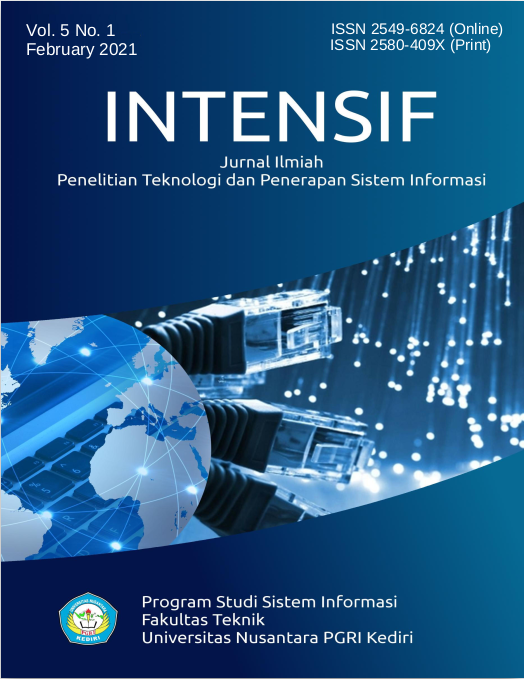Integration of Zachman Framework and TOGAF ADM on Academic Information Systems Modeling
DOI:
https://doi.org/10.29407/intensif.v5i1.14678Keywords:
Zachman Framework, TOGAF, ADM, Architecture, EnterpriseAbstract
Zachman Framework (ZF) and The Open Group Architecture Framework (TOGAF) are Architecture Frameworks often used in Architecture Enterprise's implementation. Each side of the two architecture Frameworks has advantages and disadvantages. Sekolah Tinggi Manajemen Informatika dan Komputer Muhammadiyah Paguyangan Brebes (STMIK MPB) is a new university established on April 28, 2017; STMIK MPB as a new university has no plans in building an information system. The research will select the parts that exist in the ZF and TOGAF methodologies. The two methods will be combined and compiled to be applied to the Academic Information System modeling or blended methods. These research results are architectural blueprints that can be used as a reference in the development of academic information systems.
Downloads
References
A. Hakim, H. Saragih, And A. Suharto, “Jurnal Sistem Informasi ( Journal Of Information Systems ). Sist. Inf., Vol. 10, No. 2, Pp. 83–86, 2014.
B. Azhar, F. Abdul, And R. Imam, “Enterprise Architecture Planning Sistem Informasi Akademik Dengan Togaf Adm,” J-Sakti (Jurnal Sains Komput. dan Inform., Vol. 3, No. 1, P. 1, 2019.
R. Supardi, “Pengembangan Model Arsitektur Enterprise Sistem Informasi Menggunakan Eap Pada Perguruan Tinggi (Studi Kasus di Universitas Dehasen Bengkulu),” J. Media Infotama, Vol. 12, No. 1, Pp. 70–78, 2016.
S. Sunardi, I. Riadi, And P. A. Raharja, “Analisis Application Programming Interface Pada Mobile E-Voting Menggunakan Metode Test-Driven Development,” Techno (Jurnal Fak. Tek. Univ. Muhammadiyah Purwokerto), Vol. 20, No. 2, P. 87, 2019.
N. Safitri And R. Pramudita, “Pengembangan Kerangka Kerja Arsitektur Enterprise,” Bina Insa. Ict J., Vol. 4, No. 1, Pp. 73–82, 2017.
I. S. Wartika, “Analisis Perbandingan Komponen dan Karakteristik Enterprise Architecture Framework"Konferensi Nasional Sistem dan Informatika, Stikom Bali 2011.
A. F. Husni, “Analisis Dan Pengembangan Sistem Informasi Akademik Dengan Permodelan Enterprise Architecture Zachman Framework Pada Politeknik Jambi,” J. Inf. Politek. Indonusa Surakarta, Vol. 1, No. 3, Pp. 1–9, 2016.
Ban-Pt, 2007, “Kumpulan Instrumen Standar 11 Sistem Informasi Institusi Perguruan Tinggi, Departemen Pendidikan Nasional.” .
O. Moscoso-Zea, S. Luján-Mora, C. E. Cáceres, and N. Schweimanns, “Knowledge Management Framework Using Enterprise Architecture And Business Intelligence,” Inf. Syst., Vol. 1, No. Iceis, Pp. 244–249, 2016.
R. Pramudita, And N. Safitri, “Integrasi Zachman Framework dan Togaf ADM ( Architecture Development Method ),” Inf. Syst. Educ. Prof., Vol. 1, No. 2, Pp. 157–166, 2016.
H. Hasanah, “Teknik-Teknik Observasi,”Vol 8, No 1 Pp. 21–46.2016.
T. O.Nyumba, K. Wilson, C. J. Derrick, And N. Mukherjee, “The Use Of Focus Group Discussion Methodology: Insights From Two Decades of Application In Conservation,” Methods Ecol. Evol., Vol. 9, No. 1, Pp. 20–32, 2018.
A. Sri, M. Dewi, And A. Wirajaya, “Pengaruh Struktur Modal, Profitabilitas dan Ukuran Perusahaan Pada Nilai Perusahaan,” E-Jurnal Akunt., Vol. 4, No. 2, Pp. 358–372, 2013.
K. Dilip And P. Rajeev, “Value Chain: A Conceptual Framework,” Int. J. Inf. Eng. Manag. Sci., Vol. 7, No. 1, Pp. 74–77, 2016.
T. O. Group, “Sample Catalogs, Matrices And Diagrams,” Pp. 1–71, 2011.
J. Brady, M., & Poonam, Exploring The Use Of Entity-Relationship Diagramming As A Technique To Support Grounded Theory Inquiry. Bradford: Emerald Group. 2010.
M. Lankhorst, Enterprise Architecture At Work - Enterprise Modeling, Communication, And Analysis - Second Edition, Vol. 36. 2013.
Downloads
Published
Issue
Section
License
Authors who publish with this journal agree to the following terms:
- Copyright on any article is retained by the author(s).
- The author grants the journal, the right of first publication with the work simultaneously licensed under a Creative Commons Attribution License that allows others to share the work with an acknowledgment of the work’s authorship and initial publication in this journal.
- Authors are able to enter into separate, additional contractual arrangements for the non-exclusive distribution of the journal’s published version of the work (e.g., post it to an institutional repository or publish it in a book), with an acknowledgment of its initial publication in this journal.
- Authors are permitted and encouraged to post their work online (e.g., in institutional repositories or on their website) prior to and during the submission process, as it can lead to productive exchanges, as well as earlier and greater citation of published work.
- The article and any associated published material is distributed under the Creative Commons Attribution-ShareAlike 4.0 International License












